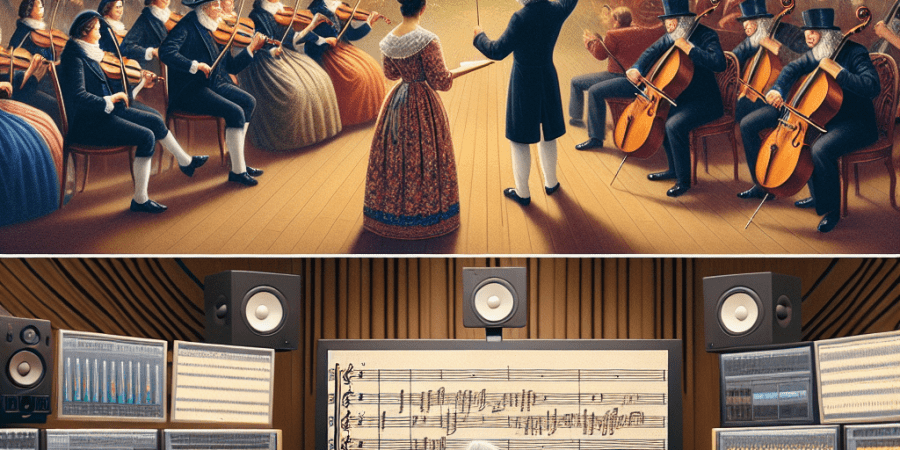The Evolution of Orchestration: From Classical Symphonies to Modern Film Scores
Orchestration, the art of arranging music for an orchestra, has come a long way from the grandiose symphonies of the Classical era to the evocative soundscapes of modern film scores. This evolution reflects changes in technology, cultural influences, and the perpetual drive to innovate. In this article, we will take a delightful journey through time to understand how orchestration has transformed over the centuries, all while finding some humor and a bit of musical trivia along the way.
The Classical Symphony: Where It All Began
Let’s start our orchestral odyssey in the 18th century. The Classical era, dominated by maestros like Wolfgang Amadeus Mozart, Joseph Haydn, and Ludwig van Beethoven, was the birthplace of the symphony as we know it. During this period, the orchestra was neatly structured with a balanced mix of strings, woodwinds, brass, and percussion instruments.
The typical classical symphony was a grand affair, often composed of four movements with varying tempos and dynamics. It was a time when composers followed strict forms and rules but still managed to stamp their unique identities onto their creations. Beethoven’s bold use of expanded orchestrations, for instance, foretold the Romantic era’s more expressive and grandiose style.
- Mozart: The rockstar of his time, composing over 600 works before the age of 36. Talk about #lifegoals!
- Haydn: The **Father of the Symphony**, composing 104 symphonies. His instrument of choice in orchestration was the surprise!
- Beethoven: His Ninth Symphony added a full chorus and soloists, breaking traditional boundaries. “Ode to Joy” indeed!
The Romantic Era: Colorful and Expressive
As we waltz into the 19th century, orchestrators began to embrace more freedom. The Romantic era was characterized by emotional depth, richer harmonies, and expanded orchestras. Composers like Hector Berlioz, Richard Wagner, and Johannes Brahms lavished listeners with lush, complex orchestrations that aimed to stir the soul.
One of the period’s hallmarks was the use of leitmotifs—a musical phrase associated with a particular idea, character, or place. Wagner, in particular, used this technique masterfully in his operas, prefiguring the modern film score’s thematic approach.
- Berlioz’s “Symphonie Fantastique”: A groundbreaking work featuring an eerie “Dies Irae.” Spooky!
- Wagner’s **Ring Cycle**: All four operas combined run about 15 hours. Better pack a lunch (or two)!
- Brahms’ Symphony No. 1: Took him over 14 years to complete. Procrastinators take note: it pays off!
The 20th Century: Bridging Classical and Modern
The 20th century heralded extraordinary diversity in orchestral music, from the impressionistic works of Claude Debussy to the stark modernism of Igor Stravinsky. This period saw the incorporation of non-traditional instruments, novel harmonic languages, and new forms of musical expression.
One of the significant shifts was the arrival of jazz influences and the advent of film scores. Pioneers like Erich Wolfgang Korngold and Bernard Herrmann began to adapt orchestral techniques to the silver screen, giving birth to the film score as we know it today.
- Debussy’s “La Mer”: An impressionistic take on the ocean’s waves. Just don’t get seasick!
- Stravinsky’s “The Rite of Spring”: Caused a riot at its premiere. Talk about a head-banging debut!
- Korngold and Herrmann: The gods of early film scores. Their music practically narrates itself!
Modern Film Scores: The Symphony’s Grandchild
And here we are, in the age where films are scored with the same artistry that once went into composing symphonies for concert halls. Composers like John Williams, Hans Zimmer, and Ennio Morricone have become household names, their movie soundtracks gaining as much fame as the films themselves.
Modern film scores employ a vast palette of sounds, including electronic elements, synthesized noises, and traditional orchestras. They serve as a crucial emotional guide for storytelling, helping directors weave intricate narratives that resonate with viewers worldwide.
If you’re intrigued by the nexus of classical orchestration and modern music, you might find some amazing recommendations on [Popular Music Channels on Telegram](https://telegram-store.com/catalog/product-category/channels/music), where enthusiasts gather to share and discover contemporary musical gems.
The Future of Orchestration
What does the future hold for orchestration? With advancements in technology, virtual instruments, and AI, the possibilities are endless. Yet, the essence remains the same: to craft music that moves us, whether it’s through the timeless beauty of a classical symphony or the heart-pounding excitement of a movie score.
So, the next time you hear that swelling orchestra in your favorite film, remember: It’s a testament to centuries of musical evolution. Here’s to many more harmonious years ahead!
And if you’re looking to expand your musical horizons, why not explore the [Audio Content on Telegram Channels](https://telegram-store.com/catalog/product-category/channels/music)? You never know what hidden musical treasures you might discover.
Until next time, keep your ears open and your hearts in tune!
